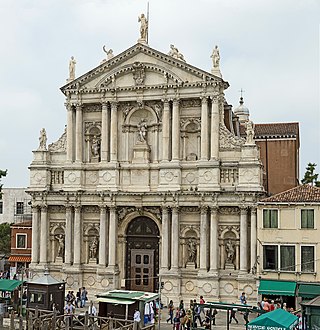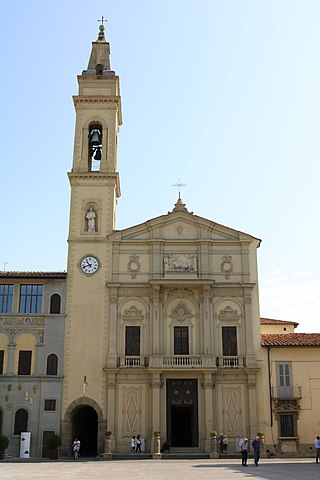
The Collegiata di Santa Maria Assunta or Duomo di San Gimignano is a Roman Catholic collegiate church and minor basilica in San Gimignano, in Tuscany in central Italy. It contains important cycles of Renaissance frescoes by artists including Domenico Ghirlandaio, Benozzo Gozzoli, Taddeo di Bartolo, Lippo Memmi and Bartolo di Fredi. It falls within the UNESCO World Heritage Site of the "Historic Centre of San Gimignano", with its frescoes being described by UNESCO as "works of outstanding beauty".

The Basilica of San Frediano is a Romanesque church in Lucca, Italy, situated on the Piazza San Frediano.

Camaiore is a city and comune of 32,513 inhabitants within the province of Lucca, Tuscany, central-western Italy. It stretches from the Apuan Alps to the east, to the plains and the coast of Versilia to the west.

The Porto Cathedral is a Roman Catholic church located in the historical centre of the city of Porto, Portugal. It is one of the city's oldest monuments and one of the most important local Romanesque monuments.

Prato Cathedral, or Cathedral of Saint Stephen, is a Roman Catholic cathedral in Prato, Tuscany, Central Italy, from 1954 the seat of the Bishop of Prato, having been previously, from 1653, a cathedral in the Diocese of Pistoia and Prato. It is dedicated to Saint Stephen, the first Christian martyr.

Santa Maria del Carmine is a church of the Carmelite Order, in the Oltrarno district of Florence, in Tuscany, Italy. It is famous as the location of the Brancacci Chapel housing outstanding Renaissance frescoes by Masaccio and Masolino da Panicale, later finished by Filippino Lippi.

San Francesco della Vigna is a Roman Catholic church in the Sestiere of Castello in Venice, northern Italy.

Pistoia Cathedral, or Cathedral of Saint Zeno is the main religious building of Pistoia, Tuscany, central Italy, located in the Piazza del Duomo in the centre of the city. It is the seat of the Bishop of Pistoia and is dedicated to Saint Zeno of Verona.

Santa Maria delle Vigne is a Roman Catholic basilica church in Genoa, Italy. It was built in the 10th century. The main altar was completed in 1730 by Giacomo Antonio Ponsonelli. The church is also the final resting place of the leading early Italian composer Alessandro Stradella, who was murdered in 1682.

Santa Maria di Nazareth is a Roman Catholic Carmelite church in Venice, northern Italy. It is also called Church of the Scalzi being the seat in the city of the Discalced Carmelites religious order. Located in the sestiere of Cannaregio, near Venezia Santa Lucia railway station, it was built in the mid-17th century to the designs of Baldassarre Longhena and completed in the last decades of that century.

Santa Maria della Pieve is a church in Arezzo, Tuscany, central Italy.

The Collegiata di Castell'Arquato, also known as the Collegiata di Santa Maria, is a Romanesque-style, Roman Catholic church located in the Castell'Arquato, province of Piacenza, in Emilia-Romagna, Italy.

Avellino Cathedral is a Roman Catholic cathedral dedicated to the Assumption of the Virgin Mary and Saint Modestinus in Avellino, Campania, Italy. It is the seat of the bishops of Avellino.

Santa Maria dei Servi, or simply known as the Chiesa dei Servi, or more fully as the Church of the Nativity of the Servants of the Blessed Virgin Mary, is a 14th-century, Roman Catholic church that faces the Via Roma in Padua, region of the Veneto, Italy. This is a parish church in the vicariate of the Cathedral Basilica of Santa Maria Assunta governed by the Servite Order. The church contains outstanding works of art including a wooden crucifix by Donatello.

The Collegiate Church of Santa Maria della Scala in Chieri is a late-Gothic Roman Catholic collegiate church, and the principal church or duomo, in the town of Chieri, Province of Turin, region of Piedmont, Italy.
Santa Maria Assunta di Castelnuovo is a Roman Catholic church located on Via Angelo Giunta in the town limits of Recanati, province of Macerata, in the region of Marche, Italy. It is the oldest church structure in town.

Montalto Cathedral, otherwise the Basilica of Santa Maria Assunta e San Vito, is the principal Roman Catholic church of the town of Montalto delle Marche, province of Ascoli Piceno in the region of Le Marche, Italy. It is dedicated to the Assumption of the Virgin Mary. The church was formerly, from 1586, the episcopal seat of the Diocese of Montalto. When the diocese was subsumed into the present Diocese of San Benedetto del Tronto–Ripatransone–Montalto in 1986, Montalto Cathedral became a co-cathedral in the new diocese. It was created a basilica minor by Pope Paul VI in 1965.

San Giovanni Battista is a Gothic and Romanesque style, Roman Catholic church in Piazza San Giovanni in the historic center of Gubbio, Umbria, in Italy.

The Insigne Collegiata di San Lorenzo is a church in Piazza Varchi of central Montevarchi, Province of Arezzo, Tuscany, central Italy. Attached to the church is a small museum of sacred art, which includes a reconstructed chapel (tempietto) bedecked with panels by Andrea della Robbia.

Santo Stefano or San Giovanni Battista e Santo Stefano is a mixed Romanesque-style, Roman Catholic rural parish church, located in the Piazza Don Renzo Gori in the frazione of Pieve, located south east of Camaiore in the province of Lucca, Tuscany, Italy.



















